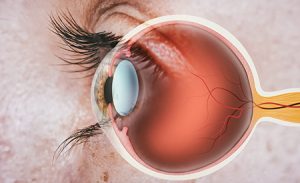Click here to resize type
Fuch’s Dystrophy in Jupiter
About Fuch’s Dystrophy

Fuch’s dystrophy is a disease affecting the cornea and occurs when the endothelium (corneal cells) slowly dies off. These special cells draw fluid out of the cornea to help it remain clear. When they are no longer around, fluid accumulates and as a result, the cornea swells and thickens, which ultimately affects vision. The condition may also affect the shape of the cornea, leading to additional vision issues. Fuch’s dystrophy has two main stages, and it is important to be aware of any symptoms that could indicate the presence of the condition. Fuch’s dystrophy usually affects both eyes and vision gradually worsens over the years.
Causes
The risk of developing Fuch’s dystrophy increases if you have a family history of the disease. It can be passed down from parent to child, and if one parent has the condition, you have a 50% chance of developing it at some point. Fuch’s dystrophy is also more likely to develop in women than men. Issues with vision usually do not become apparent until age 50. However, the disease may be detectable in some people in their 30s and 40s.
Symptoms
The symptoms of Fuch’s dystrophy can be categorized by the development stage of the disease.
Stage 1: In the early stage of Fuch’s dystrophy, patients may not notice any symptoms. It is possible that vision is a bit fuzzy upon waking in the morning, but it usually clears up as the day progresses. This is because the eyes remain moist when closed; however, this moisture dries up when you are awake.
Stage 2: As the disease progresses, you may notice that your morning blurry vision does not improve throughout the day like it normally would. Excess fluid in the eye accumulates while you are asleep, and it does not dry up as the day goes on. The disease is also responsible for the development of small blisters on the surface of the cornea in this stage. These blisters grow larger and larger until they eventually pop, causing eye pain.
Additional symptoms include:
- The sensation of a foreign object in the eye due to tiny blisters on the cornea’s surface
- Glare or halos around lights
- Eye sensitivity, especially in the presence of bright light
- Worsened eye and vision issues in humid environments
- Hazy vision due to corneal scarring
Treatment Options
There is no known prevention of Fuch’s dystrophy, and the disease cannot be cured. However, there are treatment options available to you to help reduce vision issues. Your exact course of treatment depends on how the disease has affected the endothelial cells in the eye as well as the stage of the disease.
Early-stage treatment: Medicated eye drops can help control the swelling of the cornea, helping you see more clearly. In some cases, blowing warm air onto the face can help dry the cornea’s surface.
Late-stage treatment: When vision has been significantly affected by the disease, you may need a corneal transplant. Endothelial keratoplasty is a surgery that transplants healthy endothelial cells directly into the cornea. A full corneal transplant involves replacing the scarred center of the cornea with a healthy donor cornea.
Fuch’s Dystrophy Treatment in West Palm Beach
Our team of experienced eye doctors is here to support you on your path to improved vision and is committed to delivering state-of-the-art treatment for all eye conditions, including Fuch’s dystrophy. Learn more about your treatment options at Mittleman Eye. Patients can make an appointment directly online, or they can text or call 561-500-2020 to start a conversation and make an appointment.
















